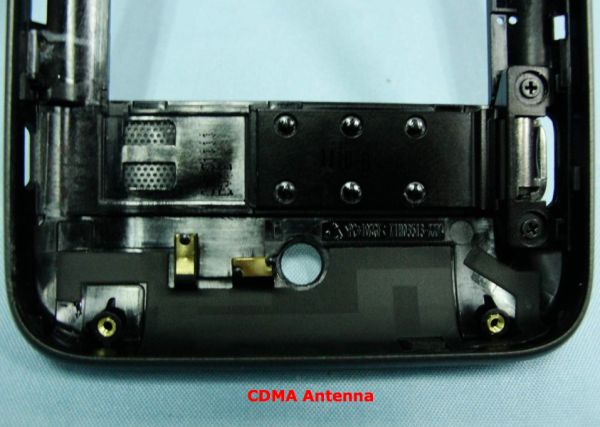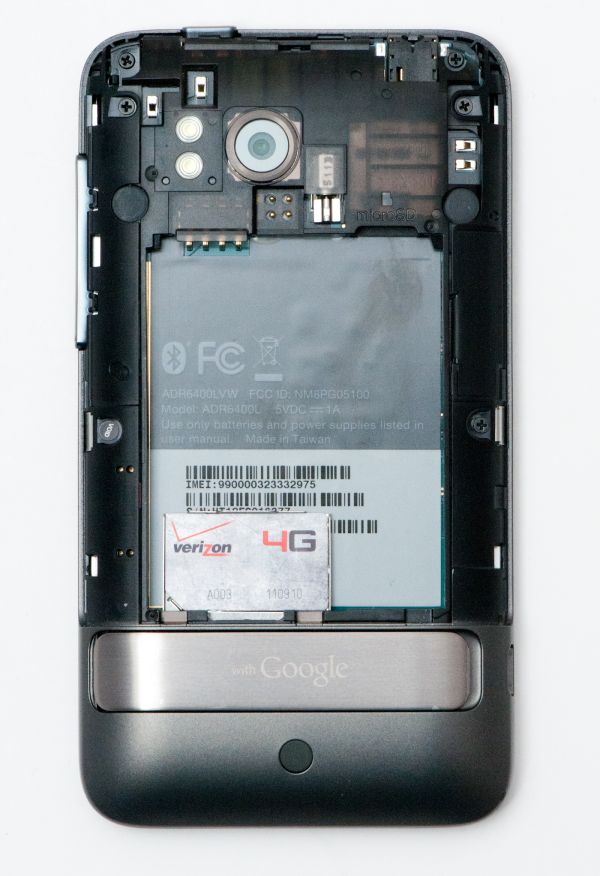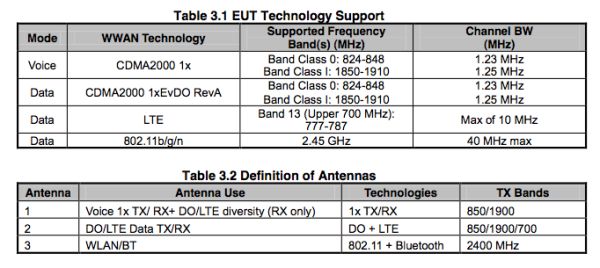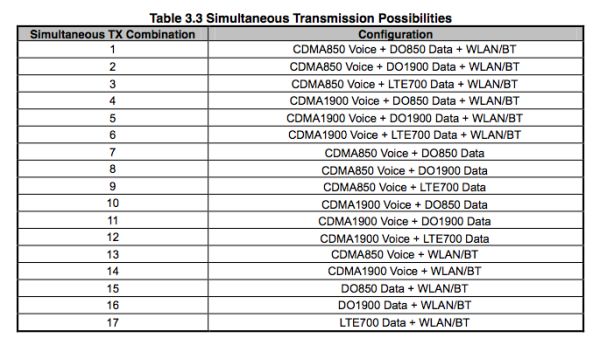HTC Thunderbolt Review: The First Verizon 4G LTE Smartphone
by Brian Klug on April 27, 2011 12:12 AM EST- Posted in
- Smartphones
- HTC
- Verizon
- LTE
- 4G
- Android
- HTC Thunderbolt
- Mobile
- MDM9600
- MSM8655
A Tale of Two Cellular Radios
I suppose now is as good a time as any to delve into the dual transceiver situation on the Thunderbolt. The two transceivers I speak of are the MSM8655’s built in cellular baseband (like all Qualcomm SoCs, you get a modem for free), and the MDM9600 which sits at the heart of every single other Verizon LTE product except the LG VL600 data card, which uses LG’s own L2000 chipset. If you want the short story, the Thunderbolt fully supports simultaneous CDMA2000-1x voice and 3G EVDO or 4G LTE data. The way this is done should already be somewhat obvious - the MSM8655 gives the Thunderbolt a continual free CDMA 1x connection for voice, SMS, and slow data, and the MDM9600 does all the 3G EVDO and 4G LTE data heavy lifting. What this boils down to is real SVDO (Simultaneous Voice Data Optimized) and SVLTE (Simultaneous Voice and Long Term Evolution data).

You can see proof of this in the Thunderbolt’s EPST menus, where there’s a second additional field marked “9k” which clearly is for the MDM9600 (9600, 9k, ahh right).
This situation also starts to become clear when you pry the battery cover off the back of the phone. Getting the battery cover off is incredibly difficult the first time. I swear I almost broke the thing the first time I did it. There are seriously more than ten plastic clips and guides which hold the door securely in position.
The Thunderbolt comes by default with a 1400 mAh, 3.7 VDC (5.18 Whr) battery (the official extended battery is 2750 mAh, 3.7 VDC, 10.18 Whr, as an aside). If you remove the battery, you can access the Thunderbolt’s USIM which slides out long ways first in a metal carrier. This is the first time I’ve seen a SIM door insert this way, but it works.
While we're talking about SIMs, Verizon's is technically both a CSIM and USIM. CDMA credentials are on the SIM (CSIM) as well as the credentials for LTE (USIM). The way the term SIM is abused lately for anything resembling one will likely continue, but if you're going to be pedantic, it's really both. Anyhow, as a result, you can finally swap devices on Verizon without having to call support, give them an ESN, and wait for routing tables to switch everything over. I haven't personally tried it since I don't have two Thunderbolts, but Verizon does advertise this is as a notable feature that finally brings full device portability. This is a huge feature if you intend to swap between devices a lot.
The reason why it’s held on so securely makes sense the second you get it off - there are two antennas back here built into the door. The reason for such a stiff and beefy door is so that no fewer than four independent contacts need to be held in good electrical contact. Count them - two contacts for the top right connector, another for top left, and another for wireless induction charging if you go with the extended battery combo.
Though we never reviewed it formally, the myTouch 4G was the first time I saw HTC start to go down the modular antenna route, with a similarly detachable (internal) antenna board. The Thunderbolt does the same thing here, yet builds it into the battery door. Likewise, the HTC Desire HD does the same thing, as does the upcoming Sensation. It isn’t just Apple that gets creative with antennas now and then, HTC deserves some credit too.
The antenna on the left is for GPS and even bears a marking to that effect on the flex board. The one on the right is for the MDM9600 and thus works for data on LTE and EVDO. There are two holes which punch clean through to the opposite side, clearly to ensure good contact with whatever antenna is built into this battery door.
There are two more antennas on the Thunderbolt, bringing the grand total to four. There’s one in the flex style we’re used to seeing which curves around the back and is for WiFi and BT, and another at the bottom right where we’re used to seeing them for CDMA 1x.
 CDMA 1x Antenna at the bottom, Source: FCC
CDMA 1x Antenna at the bottom, Source: FCC
That’s a bit of a simplification too. If you’ve read anything about LTE or our other piece on it, you should know by now that a large part of the specification is mandatory multiple antenna support. At least on Verizon’s LTE network all devices need to be category 2 or 3, which means they must incorporate MIMO. The HTC Thunderbolt’s UL MIMO configuration is 1x2, meaning it has 1 transmit antenna and 2 receive antennas. The RF chains for both the MSM8655 and MDM9600 basebands are independent, however the two share an Rx antenna at the bottom in the traditional spot. This antenna serves as 1x voice Tx/Rx for the MSM8655, and EVDO/LTE Rx for the MDM9600.
The one at the top is EVDO/LTE Tx/Rx for the MDM9600. You can verify this yourself if you pry the back cover off the phone while in an LTE or EVDO data session - it goes away and you promptly fall back to slow 1x data. Pretty cool though.
I spent a lot of time on the phone with Qualcomm talking about the radios in the Thunderbolt and LTE in general. I ended up learning a ton more about the number of design challenges involved with making SVDO and SVLTE work for the first time and gained an appreciation for even more complexities than I expected.
First off, since this is the first phone (I’m aware of) with dual cellular transceivers that can be active at the same time, Qualcomm and HTC had to work with the FCC to establish proper testing to making sure the Thunderbolt meets FCC SAR (Specific Absorption Rate) requirements. Remember that although the HTC EVO 4G could have conceivably supported simultaneous 4G WiMAX and 1x voice, the feature was disabled and to my knowledge hasn’t ever been enabled. It’s for this reason - until the Thunderbolt no proper procedure for characterizing dual transceiver phones existed. (Update: Apparently the EVO does support simultaneous WiMAX data and 1x voice, thanks everyone!)
Architecting a dual-transciever cellular system that works properly with FCC SAR requirements necessitated some communication and logic between the MDM9600 and MSM8655 basebands. This is noted in addition in the FCC report for the Thunderbolt:
Although the RF circuits are independent for both transmitters, the chipset solution incorporated SVDO/SVLTE implementation does include electrical connections between the voice and data transmitters such that the device can coordinate the transmit power of both transmitters. That said, the transmitters operate independently in the sense that they independently support voice or data connection without interaction between the modems or signaling from the WWAN network.
It’s an edge case, but imagine a situation where you’re at cell’s edge transacting both LTE data and 1x voice. In that circumstance, SAR could theoretically exceed legal limits. To keep this from happening, that communication link between the MDM9600 and MSM8655 lets the Thunderbolt know the power and link budgets for both and allocate accordingly by reducing throughput on the data link. There are a whopping 17 Tx configurations that the Thunderbolt needs to support all while maintaining legal power budgets.
I tested endlessly trying to detect any 4G LTE speed degradation at the cell edge while on a voice call but never could notice anything appreciable.
This wouldn't be a complete review without a measurement to show whether the Thunderbolt is prone to deathgrip. Luckily thanks to the antenna diversity we've outlined, the Thunderbolt really isn't. I've done the due diligence of measuring the handset in our usual positions in both 3G and 4G environments.
| Signal Attenuation Comparison in dB - Lower is Better | ||||||||
| Cupping Tightly | Holding Naturally | Holding in Case | On an Open Palm | |||||
| HTC Thunderbolt - LTE | 5.3 | 2.5 | - | 4.4 | ||||
| HTC Thunderbolt - EVDO | 6.5 | 0.8 | - | 7.2 | ||||
| Verizon iPhone 4 | 16.5 | 15.5 | 9.0 | 7.9 | ||||
| LG Optimus 2X | 13.7 | 9.3 | - | 5.9 | ||||
| Nexus S | 13.3 | 6.1 | - | 4.3 | ||||
| Droid 2 | 11.5 | 5.1 | - | 4.5 | ||||
| BlackBerry Torch | 15.9 | 7.1 | - | 3.7 | ||||
| Dell Streak | 14.0 | 8.7 | - | 4.0 | ||||
| Droid X | 15.0 | 5.1 | - | 4.5 | ||||
| AT&T iPhone 4 | 24.6 | 19.8 | 7.2 | 9.2 | ||||
| iPhone 3GS | 14.3 | 1.9 | 3.2 | 0.2 | ||||
| HTC Nexus One | 17.7 | 10.7 | 7.7 | 6.7 | ||||
The Thunderbolt has noticeably less attenuation when held in a 4G LTE scenario, no doubt thanks in part to the fact that it's fully leveraging MIMO and also on a 700 MHz carrier. I was surprised to see that make any measurable difference. I also saw a considerable amount of variance before the number settled down, which to me definitely indicates some DSP deciding on what link it can reliably hang onto in LTE coverage. In 3G EVDO the picture isn't as complicated, again attenuation is low until you put flesh over both antennas like what happens when it's on an open palm.
















71 Comments
View All Comments
Omid.M - Thursday, April 28, 2011 - link
A friend "in the know" (yeah, yeah) said HTC accidentally shipped it with S-ON for that portion of the internal storage, and that HTC had (has?) issued an OTA that will allow the full 8GB to be useable. Not sure if it's been pushed, as I don't have the Thunderbolt.Brian,
1) How quickly did GPS lock?
I feel like some of these issues that users experience with other phones---e.g. GPS lock on SGS phones---should be considered for reviews of future phones. I know it can be a hassle, but it should highlight that some issues are manufacturer specific. Hopefully, it lights a fire under mfrs. to correct these problems, if they see that other phones don't suffer from the same.
2) Also, maybe I missed it, but has AnandTech established a Light-Moderate-Heavy usage pattern for phones to test battery life?
i.e., Moderate = 45 min of Bluetooth, 20 min GPS navigation, 10 phone calls, 50 sms, 20 still pictures, etc ?
I saw you set display brightness to 50% and loaded web pages, but I'm talking about how a user would normally use the phone: calls, sms, pictures, BT, GPS...etc.
I am positive you guys have done it before.
Really amazing review. Have been spreading the word, hoping more people flock to AnandTech. You guys deserve the recognition!
@moids
Brian Klug - Thursday, April 28, 2011 - link
Moids,I haven't gotten any OTA updates, but that's entirely possible. Sometimes these review units get updates on a different schedule, so I have no idea. I should check whether it's S-ON or S-OFF.
I constantly forget to post about our GPS testing, possibly because I take it for granted these days that devices do it right. It's something I do test however with a bunch of phones at the same time and compare SNR for all the visible satellites using GPS-Test.
GPS locks fast, but not extremely fast. I took multiple road trips to Phoenix with the Thunderbolt doing navigation guidance. I'd say that 15 seconds with complete sky LOS is enough to get a lock. In location services it does have checkboxes for Verizon's location services and google's. I neglected to take screenshots but SNR is very good on the TB, no GPS problems here.
So the battery life test situation is continuing to evolve. We're working on and will have a system trace setup (exactly what you mention, GPS, using the phone, SMS, browsing) eventually. It's still in progress, of course it'd only work for Android comparisons at present.
Thanks for the good word as always ;)
-Brian
Omid.M - Thursday, April 28, 2011 - link
Feature requests:1) permalinking
2) Signature (with char. limit, like 40 chars, for Twitter ID,etc.)
3) Comment reply notification -- this one is HUGE. It's impossible for me to find replies to my comments, given then I can reply to an old comment (so my reply is "newer") but still buried in a sea of comments from older dates. Make sense?
4) Add Tapatalk compatibility to the AT forums. The mods said they're just waiting on Anand to approve, and I've given examples of other forums built on the same system (phpBB, etc) with equal or more users, to show that those forums are working fine and won't buckle under high traffic. Just have to register the forums (free) with Tapatalk so we can post using the Android/iOS app.
Oh, and a Wordpress style mobile version of these articles would be sweet, especially for commenting.
Come on, AT! The best tech site on the net should have these features! :D
Great work as always. Hope you nail those papers, Brian.
Omid.M - Thursday, April 28, 2011 - link
Awesome. Thanks for the reply!The OTA is coming if it hasn't already. I'll check with my source, but he said HTC definitely wanted to make the full 8 GB usable, so it was definitely a minor oversight on their part which they intend to correct.
I don't know why more manufacturers haven't built antennas into the cover. It definitely seems the way to go.
FYI,
Regarding the sig, if you could make it so the badge (to the left) has another bar below the handle where you can put, say, a Twitter ID...well, that'd be slick...hint hint.
That way, since it can only take something like a Twitter ID, you won't have to worry about junk URLs clogging up the comments section. Plus, people can retweet or tweet at individual comments.
Expect more RTs of this article shortly :)
whthawk - Friday, April 29, 2011 - link
Fascinating and easy read. Thanks!FITCamaro - Sunday, May 1, 2011 - link
I love all the people who are like "its thick and heavy....waaaa..." Man up people. Some of us like to have a phone that has some meat to it so we don't feel like we're going to break it. Nor is 5 ounces instead of 4 going to make any difference. For me even the Thunderbolt barely is noticeable when I'm holding it.floyd1 - Wednesday, May 4, 2011 - link
he folks who can tell me how can i order this htc thunderbolt???? and what is the price??? hope some one can help me my regards floyd from hollandname99 - Saturday, May 7, 2011 - link
"The Thunderbolt has noticeably less attenuation when held in a 4G LTE scenario, no doubt thanks in part to the fact that it's fully leveraging MIMO "This statement makes no sense.
(a) To know what is going on requires knowing what is being reported by that signal strength number. THE big issue with mobile radio is the VARIANCE in signal strength. This variance occurs on a timescale of 10s of ms, and a spatial scale of cm/
So when that dB number is reported, what EXACTLY is being reported? The maximum value over the past n seconds? The minimum value? A time average of the power, converted into dB? A time average of the dB rating. (Since the mapping from power to dB is non-linear, these two types of averages are VERY different),
(b) MIMO is NOT a technology to deal with a weak radio signal, in fact the exact opposite.
Given two antennas, you can use them in two DIFFERENT ways.
(i) You can use the two antennas via receive diversity, which means they each pick up an independent version of what is essentially the same signal. This is useful when the amount of signal variance means that one of the signals is frequently too weak to be useful, but usually not both, so at least one of the signals is strong enough to be useful.
ST codes like Alamouti are a fancy version of this idea.
Note --- this is useful for situation where the combination of the mean signal strength AND the variance means that the signal is sometimes too weak. It does not help if the mean strength is too low to be useful; it is a coping mechanism for a high variance.
(ii) MIMO is different. MIMO says we will use the two antennas to decode what are essentially two independent streams of data, and double our throughput. For this to work, we require that the lowest signal strength received (even in the presence of variance) not be too low. Thus this is a technology to take advantage of either a high mean signal strength, or an unusually low variance in the signal strength.
You can use your antennas to give you either diversity (more consistent reception) or MIMO (higher throughput, under good conditions), but not both.
NEITHER diversity nor MIMO can deal with a signal that is too weak. There IS multi-antenna technology that can do this (beam shaping) but I don't know if any carrier or cell-phones use this.
In other words, if this phone shows lower attenuation when being held
(a) who knows WTF that actually means, since we have no idea what is actually being measured
(b) it likely has more to do with the details of the placement and geometry of the antenna than with antenna diversity
(c) it certainly has nothing to do with the specific technology of MIMO
name99 - Saturday, May 7, 2011 - link
Having made the complaint above, congrats to Brian for taking my earlier complaints about these reviews to heart and trying to get a more comprehensive picture of the capabilities of these phones beyond mere headline numbers!Certainly, for example, the histograms are very helpful.
EvoGuy - Monday, May 16, 2011 - link
Droid Charge does not have an MDM9600 or any other Qualcomm IC.Of the four LTE smartphones coming to Verizon, only HTC has a Qualcomm LTE IC. CDMA is handled by VIA in the Charge, Q has the other three.
Also, EV-DO stands for EVolution-Data Only. "Data Optimized" is a backronym to try and cover up the fact that EV-DO cannot support voice. There was a standard called EV-DV (EVolution - Data & Voice), but it was killed by the giant IC company.